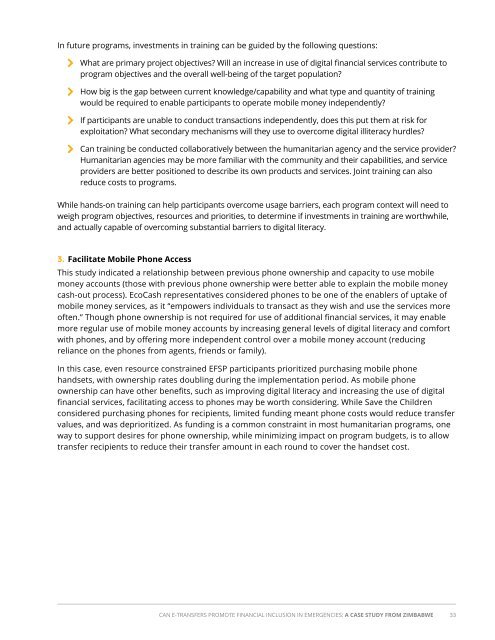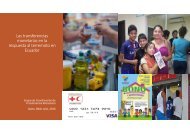Simatelele
2lF850q
2lF850q
Create successful ePaper yourself
Turn your PDF publications into a flip-book with our unique Google optimized e-Paper software.
In future programs, investments in training can be guided by the following questions:<br />
What are primary project objectives? Will an increase in use of digital financial services contribute to<br />
program objectives and the overall well-being of the target population?<br />
How big is the gap between current knowledge/capability and what type and quantity of training<br />
would be required to enable participants to operate mobile money independently?<br />
If participants are unable to conduct transactions independently, does this put them at risk for<br />
exploitation? What secondary mechanisms will they use to overcome digital illiteracy hurdles?<br />
Can training be conducted collaboratively between the humanitarian agency and the service provider?<br />
Humanitarian agencies may be more familiar with the community and their capabilities, and service<br />
providers are better positioned to describe its own products and services. Joint training can also<br />
reduce costs to programs.<br />
While hands-on training can help participants overcome usage barriers, each program context will need to<br />
weigh program objectives, resources and priorities, to determine if investments in training are worthwhile,<br />
and actually capable of overcoming substantial barriers to digital literacy.<br />
3. Facilitate Mobile Phone Access<br />
This study indicated a relationship between previous phone ownership and capacity to use mobile<br />
money accounts (those with previous phone ownership were better able to explain the mobile money<br />
cash-out process). EcoCash representatives considered phones to be one of the enablers of uptake of<br />
mobile money services, as it “empowers individuals to transact as they wish and use the services more<br />
often.” Though phone ownership is not required for use of additional financial services, it may enable<br />
more regular use of mobile money accounts by increasing general levels of digital literacy and comfort<br />
with phones, and by offering more independent control over a mobile money account (reducing<br />
reliance on the phones from agents, friends or family).<br />
In this case, even resource constrained EFSP participants prioritized purchasing mobile phone<br />
handsets, with ownership rates doubling during the implementation period. As mobile phone<br />
ownership can have other benefits, such as improving digital literacy and increasing the use of digital<br />
financial services, facilitating access to phones may be worth considering. While Save the Children<br />
considered purchasing phones for recipients, limited funding meant phone costs would reduce transfer<br />
values, and was deprioritized. As funding is a common constraint in most humanitarian programs, one<br />
way to support desires for phone ownership, while minimizing impact on program budgets, is to allow<br />
transfer recipients to reduce their transfer amount in each round to cover the handset cost.<br />
CAN E-TRANSFERS PROMOTE FINANCIAL INCLUSION IN EMERGENCIES: A CASE STUDY FROM ZIMBABWE 33



